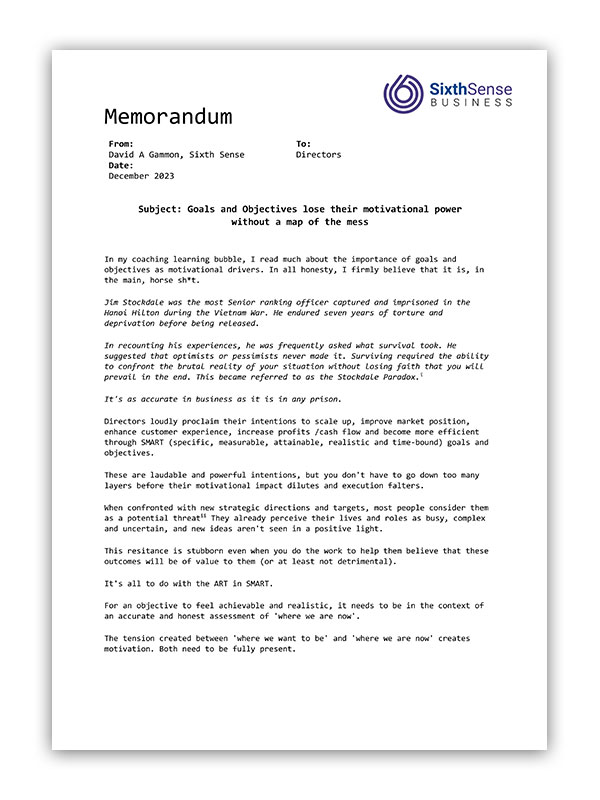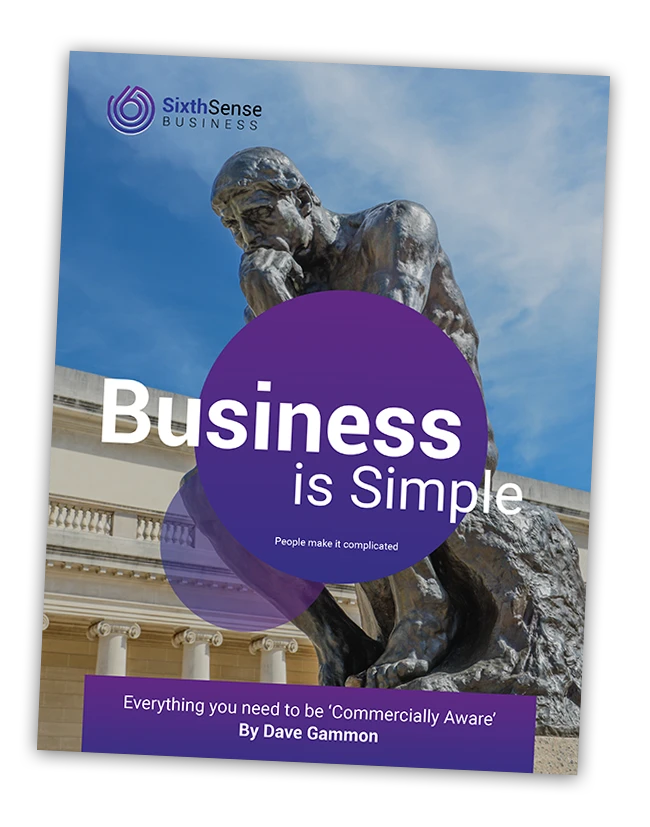From:
David A Gammon, Sixth Sense
To:
Directors
Date:
December, 2023
Goals and Objectives lose their motivational power without a map of the mess
In my coaching learning bubble, I read much about the importance of goals and objectives as motivational drivers. In all honesty, I firmly believe that it is, in the main, horse sh*t.
Jim Stockdale was the most Senior ranking officer captured and imprisoned in the Hanoi Hilton during the Vietnam War. He endured seven years of torture and deprivation before being released.
In recounting his experiences, he was frequently asked what survival took. He suggested that optimists or pessimists never made it. Surviving required the ability to confront the brutal reality of your situation without losing faith that you will prevail in the end. This became referred to as the Stockdale Paradox (1).
It’s as accurate in business as it is in any prison.
Directors loudly proclaim their intentions to scale up, improve market position, enhance customer experience, increase profits /cash flow, and become more efficient through SMART (specific, measurable, attainable, realistic and time-bound) goals and objectives.
These are laudable and powerful intentions, but you don’t have to go down too many layers before their motivational impact dilutes and execution falters.
When confronted with new strategic directions and targets, most people consider them as a potential threat(2). They already perceive their lives and roles as busy, complex, and uncertain, and new ideas aren’t seen in a positive light.
This resistance is stubborn even when you do the work to help them believe that these outcomes will be of value to them (or at least not detrimental).
It’s all to do with the ART in SMART.
For an objective to feel achievable and realistic, it needs to be in the context of an accurate and honest assessment of ‘where we are now’.
The tension created between ‘where we want to be’ and ‘where we are now’ creates motivation. Both need to be fully present.
But we often don’t know ‘where we are now’. It’s complex, has many moving and human parts. Objective data can be challenging to find.
In the face of this complexity, we get lazy and default to long-held beliefs, opinions, and generalisations (3).
This is especially true when considering additional resources, prioritising activities, and determining realistic timelines.
So motivational goals require a vivid and excited future, coupled with a firm understanding of brutal reality.
Luckily, there is a solution to hand.
I was working with one of my clients’ account managers. He was trying to persuade the business owner to give him more resources. His preparation was poor, and his argument largely hinged on persuading his boss how much hamster wheeling he was engaged in.
He needed to do better.
We came up with an idea: a map of the mess. A thorough and honest analysis of ‘where we are now’.
We brainstormed items (4) and created a list of subjects to be added to the map.
- His beliefs and concerns about the direction of the company and how he needs to develop to deliver his goals
- The team’s skills, knowledge, potential and attitude
- What customers were and weren’t saying about service levels and communication
- What elements of his brief he was/wasn’t on top of in terms of business-as-usual activity and projects
- Where time was being used (5) and what productivity gains might be possible
- Contract profitability and how much money was being left on the table
- Contractual compliance risks the company was taking
- What activities the additional resource would enable him to commit to
- How well the current process/structure could deal with additional demands
See, I told you it was complicated, and it requires a full honesty. But it’s not just a depressing exercise in ‘brutal reality’.
When combined with clearly specified objectives, he was able to
- Create a high level of motivation and drive to create change because he now saw the gap for what it truly was (6)
- Lay out a realistic but challenging roadmap and timeline for execution
He also decided to model several options (including doing nothing) instead of putting all his eggs in one basket. This enabled the conversation with the business owner to be more in-depth about action sequence, priorities and timescales rather than a resource justification request.
This is another classic case of ‘measure twice, cut once’. If you want to reduce the overall time it takes to execute change, create positive motivation and move forward quickly, an honest (even if painful) perspective of the starting point and a vivid, exciting picture of the future state gets the job done.
- If you want to learn more about Jim Stockdale, read Good to Great by Jim Collins.
- The brain is biased toward the assumption of danger. You may know this as ‘better safe than sorry’.
- If you want to really understand how these beliefs play out, try a thought experiment. Notice what agreements and disagreements come up in your head as you read this article. Those are your belief systems in play.
- Specific to his situation.
- I’m a huge advocate of tracking time across all domains, as it means I can bring data to a resource fight.
- And in this case, the gap between where they wanted to be and where they were was not as wide as he thought.

